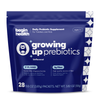How to Rebuild Gut Health After Antibiotic Use in Kids
share this article

Antibiotics are powerful medications that can save lives by fighting bacterial infections, but they can also disrupt the delicate balance of bacteria in the gut, known as the microbiome.
Restoring gut health after antibiotic treatment is essential for promoting overall well-being and preventing potential long-term health issues. Let's explore some strategies to help your kiddo rebuild their gut health both during and after antibiotic use.
Probiotics and Fermented Foods
Probiotics are live beneficial bacteria that can help replenish the gut with healthy microbes after antibiotic treatment. Studies have shown that probiotic supplementation can reduce the risk of antibiotic-associated diarrhea and support gut health [1].
Incorporating probiotic-rich foods such as yogurt, kefir, sauerkraut, and kimchi into your kiddo's diet can also help restore microbial balance in the gut.
Prebiotics
Prebiotics are dietary fibers that serve as fuel for beneficial bacteria in the gut, helping them thrive and multiply. Research has demonstrated that prebiotic supplementation can enhance the growth of beneficial bacteria and improve gut barrier function [2]. Foods rich in prebiotics include bananas, onions, garlic, asparagus, and carrots.
Daily reads to help your little ones lead happier and healthier lives.
Join the
Happy Gut Club
Dietary Fiber
Increasing dietary fiber intake can promote bowel regularity and support a healthy gut microbiome. Fiber-rich foods such as fruits, vegetables, legumes, and whole grains provide essential nutrients for beneficial bacteria in the gut [3].
Encouraging your kiddo to consume a variety of fiber-rich foods can help promote microbial diversity and improve gut health.
Avoiding Unnecessary Antibiotics
Minimizing unnecessary antibiotic use is crucial for preserving gut health and reducing the risk of antibiotic-related complications. Research suggests that up to 30% of antibiotic prescriptions in outpatient settings may be unnecessary or inappropriate [4].
Working with your healthcare provider to determine if antibiotics are truly necessary and appropriate for your kiddo's condition can help prevent unnecessary disruptions to their gut microbiome.
Gradual Reintroduction of Foods
After completing a course of antibiotics, gradually reintroducing a variety of foods into your kiddo's diet can help support gut health and minimize digestive discomfort. Start with easily digestible foods such as broth-based soups, steamed vegetables, and plain grains, and gradually introduce more complex foods as tolerated [5].
Pay attention to any signs of digestive discomfort or food sensitivities and adjust their diet accordingly.
Summary
Rebuilding gut health after antibiotic treatment is essential for promoting overall health and well-being in kiddos. Incorporating probiotics, prebiotics, dietary fiber, and gradual reintroduction of foods into their diet can help restore microbial balance in the gut and support immune function. Minimizing unnecessary antibiotic use and working closely with healthcare providers can help prevent disruptions to the gut microbiome and promote long-term gut health.
Daily reads to help your little ones lead happier and healthier lives.
Join the
Happy Gut Club
















